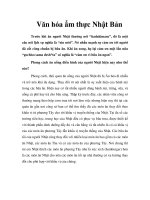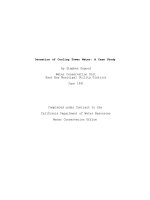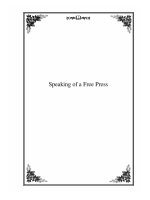Tài liệu Proportions of a Hand docx
Bạn đang xem bản rút gọn của tài liệu. Xem và tải ngay bản đầy đủ của tài liệu tại đây (832.51 KB, 12 trang )
PROPORTIONS
OF A
Brenda Hoddinott
H-02 BEGINNER: FOCUS ON PEOPLE
This project offers simple step-by-step illustrated
instructions, to guide aspiring artists through the
process of outlining a proportionately correct adult
human hand.
Human hands are without doubt very anatomically
intricate, but not nearly as difficult to draw as many
artists assume. The process of drawing a hand becomes
less intimidating when you understand how to render
the proportions properly, and can draw the fundamental
shapes of the various parts in their correct places.
Drawing supplies needed include good quality white paper, different grades of graphite pencils
(such as HB and 2B), kneaded and vinyl erasers, a pencil sharpener and a sandpaper block.
This lesson is comprised of the following three sections:
INTRODUCTION: Hands come in various shapes and sizes depending on different factors,
such as the persons’ size, age, and gender; yet the overall proportions are very similar.
PUTTING PROPORTIONS ON PAPER: Setting up accurate proportions is the
foundation of drawing hands. Fingers make up approximately half the total length of a hand.
OUTLINING THE FORMS OF A HAND: In this section, you outline the hand with thin
neat lines by constantly referring to the illustrations and your own hand.
This project is recommended for artists from age 12 to adult, as well as home
schooling, academic and recreational fine art educators.
12 PAGES – 19 ILLUSTRATIONS
Published by Hoddinott Fine Art Publishers, Halifax, NS, Canada – Revised 2006
Copyright to all articles, images, text, projects, lessons and exercises within this drawing class belong to Brenda Hoddinott and may
not be reproduced or used for any commercial purposes whatsoever without the written permission of Brenda Hoddinott.
Web sites and
- 2 -
INTRODUCTION
Human hands are without doubt very anatomically intricate, but not nearly as difficult to draw as
many artists assume. The process of drawing a hand becomes less intimidating when you
understand how to render the overall proportions properly, and can draw the basic shapes of the
various parts in their correct places. Proportion is the relationship in size of one component of a
drawing to another or others. Shape refers to the outward outline of a form. Basic shapes include
circles, squares and triangles.
The most common inaccuracy when drawing hands is making the main section of the hand too
short in relation to the length of the fingers. Have a close look at one of your own hands.
Measure the distance between the tip of the longest finger down to its base connects to the
main section of the hand (Mine is 3.2 inches).
Then, measure the hand from where the fingers attach to the hand to the section of the wrist
where the base of the thumb ends (Mine is 3.4 inches).
The two distances are very similar; hence, fingers make up approximately half the total length of
a hand.
Examine the three drawings of hands in the next illustration. Imagine each hand open to a point
where you can compare the length of the fingers to the length of the main section of the hand.
Again the distances are approximately the same. Therefore, when drawing a hand keep in mind
that the length of the longest finger is similar to the length of the main section of the hand.
ILLUSTRATION 02-01
Copyright to all articles, images, text, projects, lessons and exercises within this drawing class belong to Brenda Hoddinott and may
not be reproduced or used for any commercial purposes whatsoever without the written permission of Brenda Hoddinott.
Web sites and
- 3 -
The illustrations and instructions in this lesson will be based on an average sized hand. However,
hands come in various shapes and sizes depending on lots of different factors, including the
person’s size, age, and gender; yet the overall proportions are very similar.
In the next drawings examine three variations of hands and compare each to the rectangular
sketch beside it.
Which of the three hands in Illustrations 02-02 to 02-04 most closely resembles the overall
shape of your hand?
ILLUSTRATION 02-02
To draw a hand that is short, your sketch
will be based on a rectangle divided into two
squares of the same size (Illustration 02-02).
ILLUSTRATION 02-03
A drawing of an average hand begins with a
longer rectangle divided into two same sized
short rectangles (Illustration 02-03).
ILLUSTRATION 02-04
A slender hand with long fingers is based on
a slightly longer rectangle divided into two
equal rectangles (Illustration 02-04).
Consider using your own
hand as the model for this lesson. If you
are left handed, it’s easier to draw your
right hand, and if you are right handed
try drawing your left.
Copyright to all articles, images, text, projects, lessons and exercises within this drawing class belong to Brenda Hoddinott and may
not be reproduced or used for any commercial purposes whatsoever without the written permission of Brenda Hoddinott.
Web sites and
- 4 -
PUTTING PROPORTIONS ON PAPER
Setting up accurate proportions is the foundation of drawing hands. If the length of the longest
finger when compared to the length of the hand is drastically different, your proportions may be
incorrect; hence, no amount of beautiful shading can then save your drawing.
If you are drawing your own hand, constantly examine it as you work; use my illustrations as
guidelines only. Also, my drawing is of my left hand; if you are drawing your right hand, the
whole hand, including the fingers and thumb, will be in reverse.
1) Use an HB pencil and very lightly sketch a vertical rectangle to represent the overall
shape of a hand (refer to Illustration 02-05).
2) Divide the rectangle in half to mark the point where the base of the fingers meets the
main section of the hand.
3) Sketch the three largest fingers as in Illustration 02-06.
ILLUSTRATION 02-05 ILLUSTRATION 02-06
I often use
straight (rather
than curved)
lines to establish
the proportions
of hands.
Pay attention to
the lengths of
the fingers and
the position of
each in relation
to the others.
If you are
drawing from
my sketch, use
the sides of the
upper rectangle,
as well as
positive and
negative spaces
to help you
measure
proportions.
The thumb will
be added later.
Copyright to all articles, images, text, projects, lessons and exercises within this drawing class belong to Brenda Hoddinott and may
not be reproduced or used for any commercial purposes whatsoever without the written permission of Brenda Hoddinott.
Web sites and
- 5 -
Place a piece of clean paper under your hand as you draw (better the
drawer than the drawee!). Each time you work on a new section, remember to move
your paper so it’s always under your hand. This prevents you from smudging your
drawing, and protects the paper from the oils in your skin.
4) Lightly sketch the little finger (refer to Illustration 02-07).
5) Outline the edge of the hand that is on the same side as the little finger.
6) Sketch two lines to represent the outside edges of the wrist as in Illustration 02-08.
ILLUSTRATION 02-07 ILLUSTRATION 02-08









